

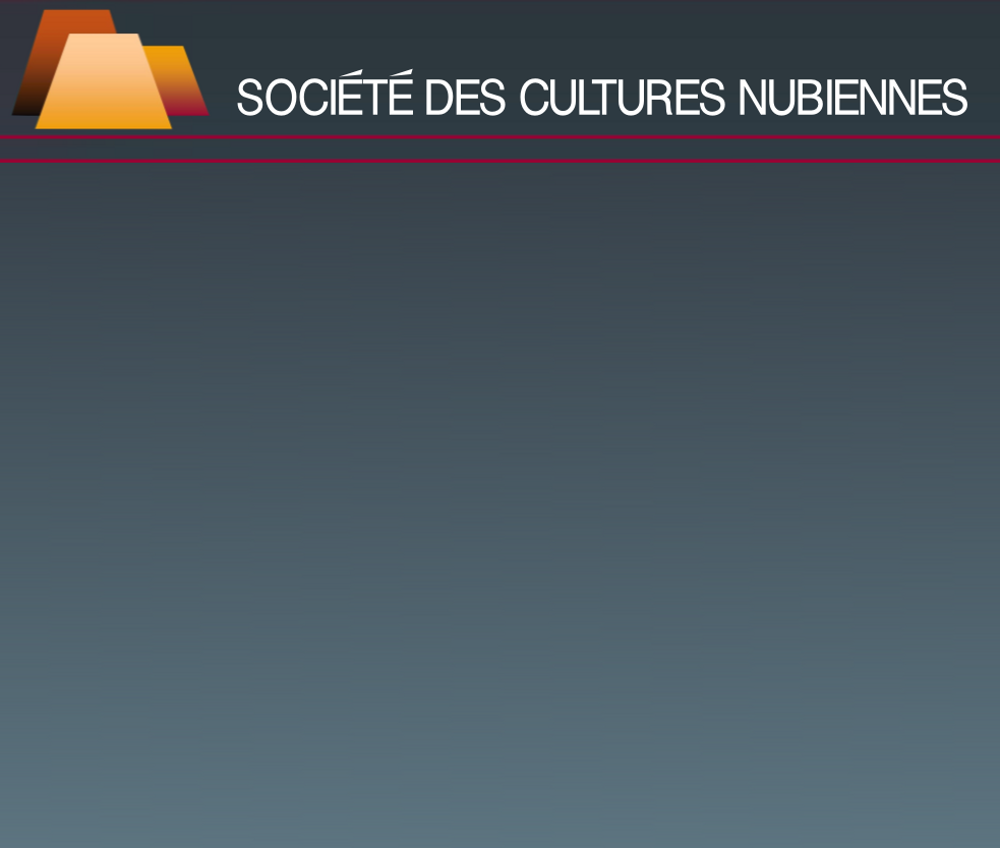
|
SOLEB The temple of Soleb was discovered in 1813 by the Swiss J.L. Burckhardt, disguised as Sheikh Ibrahim. It is also thanks to this subterfuge that he was able to visit and describe the temples at Abu Simbel.
At Soleb, six excavation campaigns led by Michela Schiff Giorgini, with the collaboration of Clément Robichon, the Abbot Josef Janssen and Jean Leclant, brought a greater understanding of the architecture and the reliefs of the remains. It is contemporary with the temple of Luxor, and has the classic structures of the Northern temples: quay, first pylon (today demolished), dromos, second pylon, two peristyle courts, a hypostyle hall, and two sanctuaries. However, the poor quality of the sandstone and the extreme climatic conditions have resulted in damage to the temple. Today, several blocks on the ground still await replacement. The Schiff Giorgini mission reconstructed and consolidated the majestic remains. The carvings on the columns highlight their Egyptian origin.
The hypostyle hall: Its decoration is very characteristic, and makes reference to: - The feast of Hed-Seb celebrated in the whole country to commemorate the jubilee of the king at the end of 30 years of reign. This type of ritual is attested in the tomb of Kheruf on the west bank at Thebes (TT192). - The deification of the king while he was still alive. On the great pylon, Amenhotep III appears as the officiator of his own adoration. He wears a disc with the crescent moon, an attribute of the child-god Khonsu and the horns of the ram of the god Amun. - The consecration of the temple by the sovereign. At the rear of the great pylon, Amenhotep III is accompanied by his family and the court. The different phases of Soleb are referred to there. - The different ethnic populations of Asia and Africa. At the base of what remains of the columns of the hypostyle hall, this ethnographic review presents the peoples subjugated to Egyptian power. It seems evident that the latter have not been vanquished by the Pharaoh. The name of the different ethnicities in inscribed in a kind of cartouche (oval shield), most commonly crenelated, surmounted by the usual iconography of the captive populations: arms tied behind the back. The faces are individualised: to the north, on the axis of the temple, the countries of Asia, and to the south, the Africans. |
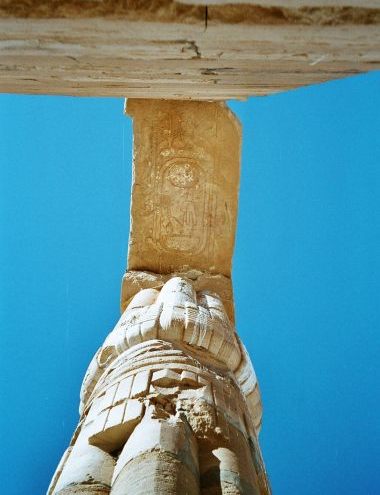 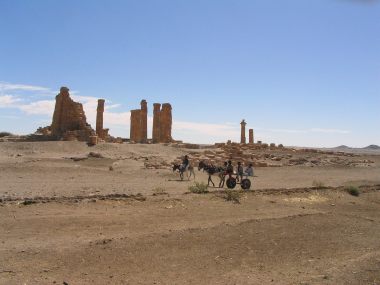 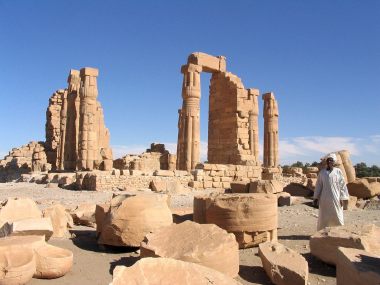 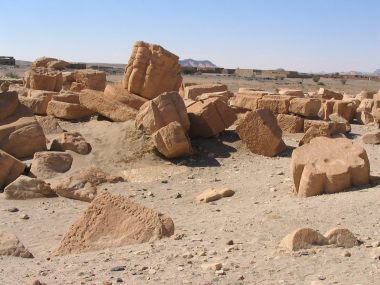 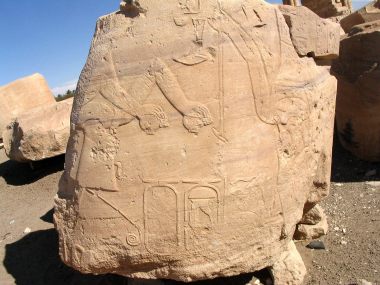 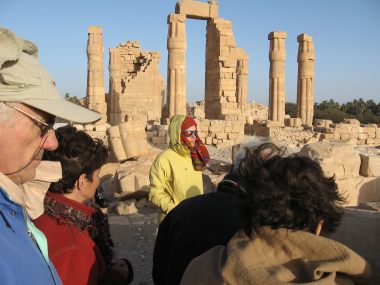 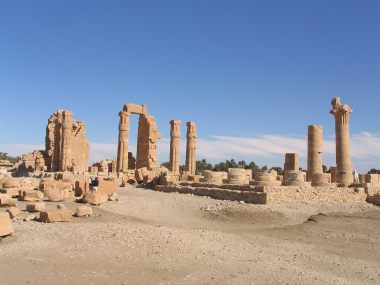 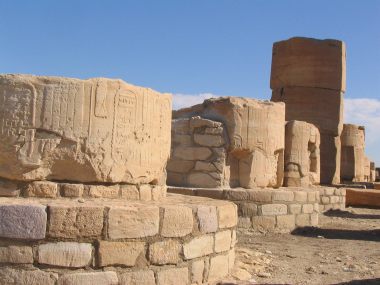 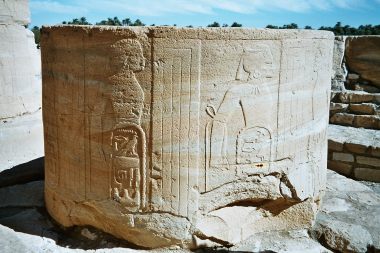 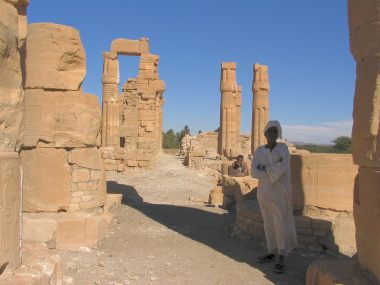 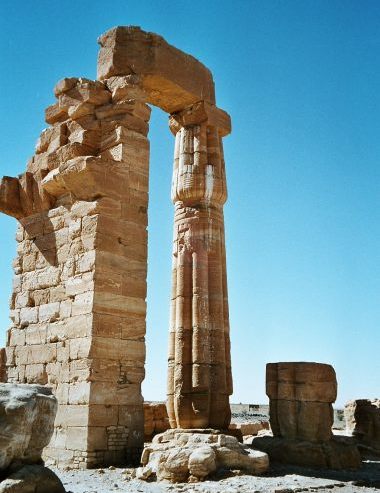 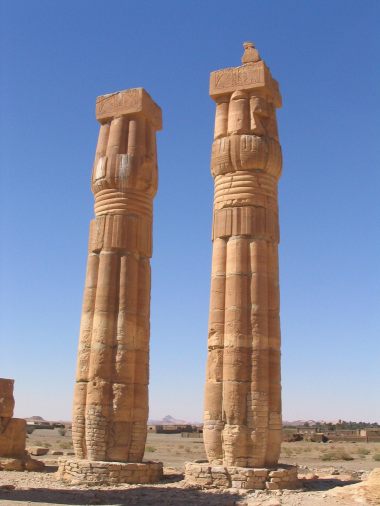 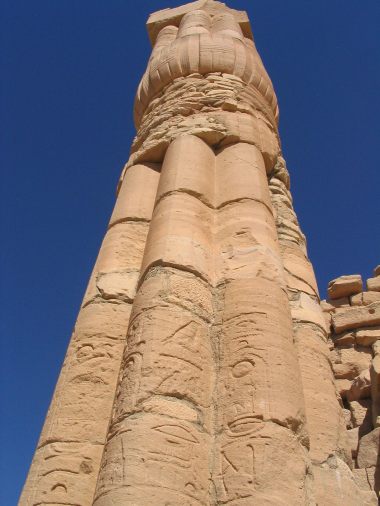 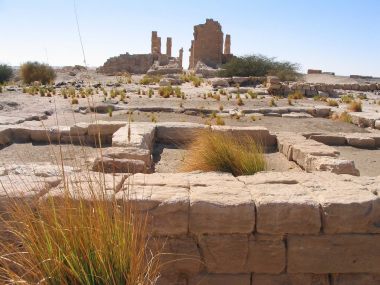 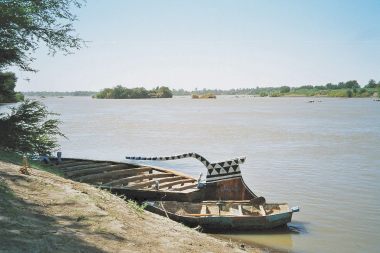 Egg-shaped royal title of Amenhotep III scarved on one architrave of the jubilee temple of this king at Soleb (downstream the Third cataract) / Cartouche d'Amenhotep III gravé sur une architrave du temple jubilaire de ce souverain à Soleb (aval de la Troisième cataracte)
Side-view of the temple of Amenhotep III at Soleb / Vue latérale du temple d'Amenhotep III à Soleb
Scarved blocks near the destroyed sanctuary of the temple of Soleb with, in the background, the hypostyle room / Blocs gravés au niveau du sanctuaire du temple de Soleb, aujourd'hui détruit, avec en arrière plan, la salle hypostyle
Ruins of fibrous columns on the northern part of the temple of Amenhotep III at Soleb / Ruines de tambours d'anciennes colonnes fasciculées déposées sur la partie nord du temple d'Amenhotep III à Soleb
Part of a column showing the king Amenhotep III, offering the nou pots to the god Amon / Tambour de colonne représentant le souverain Amenhotep III faisant offrande des pots nou au dieu Amon
Joy Soulé-Nan (in yellow) touring a group of the cultural agency Clio (Paris) at Soleb / Joy Soulé-Nan (en jaune) expliquant l'histoire du temple de Soleb à un groupe de l'agence culturelle Clio (Paris)
Northern view of the hypostyle room of the temple of Amenhotep III / Salle hypostyle vue du nord du temple d'Amenhotep III
Column bases of the hypostyle room / Bases de colonne de la salle hypostyle
One column base situated on the southern part of the hypostyle room with the representation of Nubians surmounting an egg-shaped inscription giving their origin / Base d'une colonne située sur la partie sud de la salle hypostyle avec la représentation de Nubiens surmontant un cartouche indiquant leur origine
Inner view of the hypostyle room of the temple of Soleb / Vue intérieure de la salle hypostyle du temple de Soleb
Vestiges of the peristyle room of the temple of Amenhotep III at Soleb / Vestiges de la salle péristyle du temple d'Amenhotep III à Soleb
Fibrous columns with closed lotus bud capitol of the peristyle room / Colonnes fasciculées avec chapiteau en forme de bouton de lotus fermé de la salle péristyle
Fibrous column representing the royal titles of Amenhotep III with his crowning name : Neb Maat Ra / Colonne fasciculée représentant la titulature d'Amenhotep III avec son nom de couronnement : Neb Maât Ra
Wharf giving access to the temple of Amenhotep III, temple situated on the western side of the Nile / Débarcadère donnant accès au temple d'Amenhotep III, temple situé sur la rive occidentale du Nil
Surroundings of the temple of Amenhotep III at Soleb / Alentours du temple d' Amenhotep III à Soleb
From the eastern side of the Nile, view over the other side not far away from Soleb / Depuis la rive orientale, vue sur l'autre rive, à proximité du temple de Soleb
|
|
At the beginning of the XIX century, J.C. Wilkinson continued the study begun by Lord Prudhoe and Major Felix. But the publication of the Denkmäler of R. Lepsius marked an advance in the knowledge of fifty eight name rings. During five days (summer 1844), the mission carried out remarkable work. In 1907, the University of Chicago, under the direction of the epigraphers J.H. Breasted and Davies, studied the inscriptions on the blocks, often difficult to reach. It is only with the Schiff Giorgini mission that the bases and the lower tambours of the columns are restored, making it easier to attempt a global study of the decoration of the hypostyle hall.
On some of the column bases of the south end, several tribes of the land of the Shasu are evoked. These toponyms, rendered by Ramses II in the list of the sanctuary of Amara (Lower Nubia) and of Akasha, are of great importance. According to Nicolas Grimal, the land of Shasu is an area located between the north of the Arabian Peninsula and modern-day Iraq. One of the tribes is called 'land of Shasu and of Yahweh' (Yahvé). In the northern part are the name rings coats of arms of Ascalon, Tyre, Qadesh and Byblos. Named areas are Hatti, Mitanni, Syria, Palestine, Iraq and the Euphrates.
The sanctuaries: Today these have disappeared, but one was dedicated to the god Amun, and the other to the image of the deified king. By the beginning of the first millennium before our era, the temple had probably already been destroyed. Several sculptures that decorated it (two lions in red granite, today in the British Museum, and statues of rams) had been placed in the great temple of Amun at Jebel Barkal.
According to Jean Leclant, the temple of Soleb is the powerful confirmation of the cosmic power of the Pharaoh, Egyptian order (Maat) in the face of the chaos of foreign regions, or against bad floods. The Michela Schiff Giorgini mission has also excavated the cemeteries of Soleb. The one dating to the New Kingdom contained the remains of coffins.
|
|